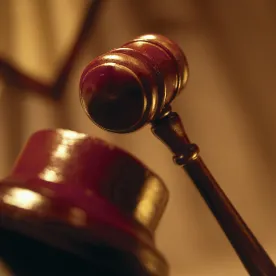The court holds that, with rare exception, intent is required for spoliation instructions in Texas.
On July 3, the Texas Supreme Court issued its ruling in Brookshire Brothers, Ltd. v. Aldridge,[1] holding, with a narrow exception, that a party must intentionally spoliate evidence in order for a trial court to give a spoliation instruction.
Background
In Brookshire, a personal injury lawsuit, the plaintiff slipped and fell near a display table in a grocery store. The plaintiff did not immediately report the incident, but he returned to the store a few days later to report his injury. One of the store’s surveillance cameras captured the fall on video. The store saved the video footage from just before the plaintiff entered the store until shortly after he left. However, additional footage from the day was destroyed pursuant to the store’s retention policy, which provided for video surveillance on a continuous loop that recorded over prior events approximately every 30 days.
Almost one year after the fall, the plaintiff’s lawyer sent the grocery chain a letter requesting that 2.5 hours of additional footage be saved. When the grocery store was unable to comply with the request because the video was recorded over almost one year earlier, the plaintiff sought a spoliation instruction, claiming that the additional footage was relevant to his claim that “it is more likely than not that the condition existed long enough to give [the defendant] a reasonable opportunity to discover it.” The trial court allowed the jury to hear evidence regarding whether the grocery store spoliated evidence and submitted a spoliation instruction to the jury.
Supreme Court’s Consideration of Spoliation
From the outset, the majority’s opinion expressed concern that a spoliation instruction “can unfairly skew a jury verdict, resulting in a judgment that is based not on the facts of the case, but on the conduct of the parties during or in anticipation of litigation.”[2] Acknowledging that a spoliation instruction “is still inherently a sanction,”[3] the court adopted a framework for assessing spoliation and the appropriate remedy for such conduct.
Determining Whether Spoliation Has Occurred
The Texas Supreme Court first provided an analytical framework for spoliation. Spoliation occurs when a spoliating party “had a duty to reasonably preserve evidence” and “the party intentionally or negligently breached that duty by failing to do so.”[4] The party alleging spoliation bears the burden to establish that a duty to preserve evidence existed and must demonstrate that the other party breached its duty.
The question of whether spoliation has occurred is a question of law that a trial court must first decide, both because spoliation is an evidentiary matter for a trial court to resolve and because “presenting spoliation issues to the jury for resolution magnifies the concern that the focus of the trial will shift from the merits to a party’s spoliating conduct.”[5] The court further noted that evidence regarding whether a party spoliated evidence is not a “fact that is of consequence to the determination of the action.”[6]
Fashioning an Appropriate Remedy for Spoliation: Assessing Culpability and Prejudice
Only after determining spoliation occurred may the trial court assess an appropriate remedy. Any discovery sanction “must have a direct relationship to the act of spoliation,” “may not be excessive,” and “must be proportionate.”[7] Key considerations for a court fashioning an appropriate remedy include “the culpability of the spoliating party and prejudice to the nonspoliating party.”[8]
In assessing culpability, a trial court must determine whether a spoliating party acted intentionally. The court found, with a narrow exception, that “a party must intentionally spoliate evidence in order for a spoliation instruction to constitute an appropriate remedy.”[9] The court reasoned that a jury instruction on spoliation is based upon a “presumption of wrongdoing, so it follows that the more appropriate requirement is intent to conceal or destroy discoverable evidence.”[10] Such intent can include what the court deemed “willful blindness,” in which a party does not directly destroy the evidence but allows its destruction to occur.[11] The court noted that such willful blindness can exist when a party with control over automatic electronic deletion systems intentionally allows relevant information to be erased.
Yet, even if a party acts intentionally, a court must still find that a less severe sanction would be insufficient to remedy the prejudice caused by the spoliation. In evaluating the prejudice resulting from spoliation, Texas courts should consider (1) the relevance of the evidence to key issues in the case, (2) the harm caused by the spoliation or whether the evidence would have been helpful to the nonspoliating party’s case, and (3) whether the spoliated evidence was cumulative of other evidence that may still be used.
Based on this culpability and prejudice analysis, the court further held that only in the rare circumstance where negligent spoliation “irreparably deprive[s the nonspoliating party] of having any meaningful ability to present a claim or defense” can a trial court issue a spoliation instruction for negligent spoliation.[12]
In applying this framework to Brookshire Brothers’ conduct, the Texas Supreme Court found that there was no evidence of intent because no evidence indicated that Brookshire Brothers only saved a portion of the footage in order to purposefully conceal relevant evidence. The court then found the plaintiff was not irreparably deprived of any meaningful ability to present his claim because other evidence was still available to the plaintiff. Thus, the court held the trial court abused its discretion in issuing a spoliation instruction.
Implications
Going forward in Texas state courts, the sanctions available for spoliation will turn on a case-specific balancing of the alleged spoliator’s culpability and the degree of prejudice suffered by the nonspoliating party. In all but the rarest circumstances, spoliation must be intentional for the imposition of a spoliation jury instruction.
[1]. No. 10-0846 (Tex. July 3, 2014), available here.
[10]. Id. at 20.



 />i
/>i

